A reading response is a written reaction or reflection to a text that highlights the reader’s understanding, interpretation, and evaluation.
It includes a summary of the main ideas found in the text, an analysis of the author’s point of view, and the reader’s personal reflection on the significance of the text. It also acts as a starting point for further discussions or research on the topic.
A template is a structured outline that is meant to guide the reader in formulating an organized, detailed, and thoughtful response to a text. This document contains prompts or questions that will encourage them to engage with the text effectively.
The benefit of using a template is to avoid including irrelevant information, unsupported claims, or failing to review different perspectives on the text when writing one. It will easily arrange your thoughts to develop a logical and persuasive response to the text. Since templates are customizable, you can use them multiple times for different subjects and grades, such as at the elementary level. They can also be used in different settings, including classrooms, personal reading sessions, or even book clubs.
This article will comprehensively highlight how a reader can share their thoughts and organize a coherent response to a text. It will also focus on the purpose of using a template for reading responses, its types, and how to write and format it.
Free Templates
Given below are downloadable templates:
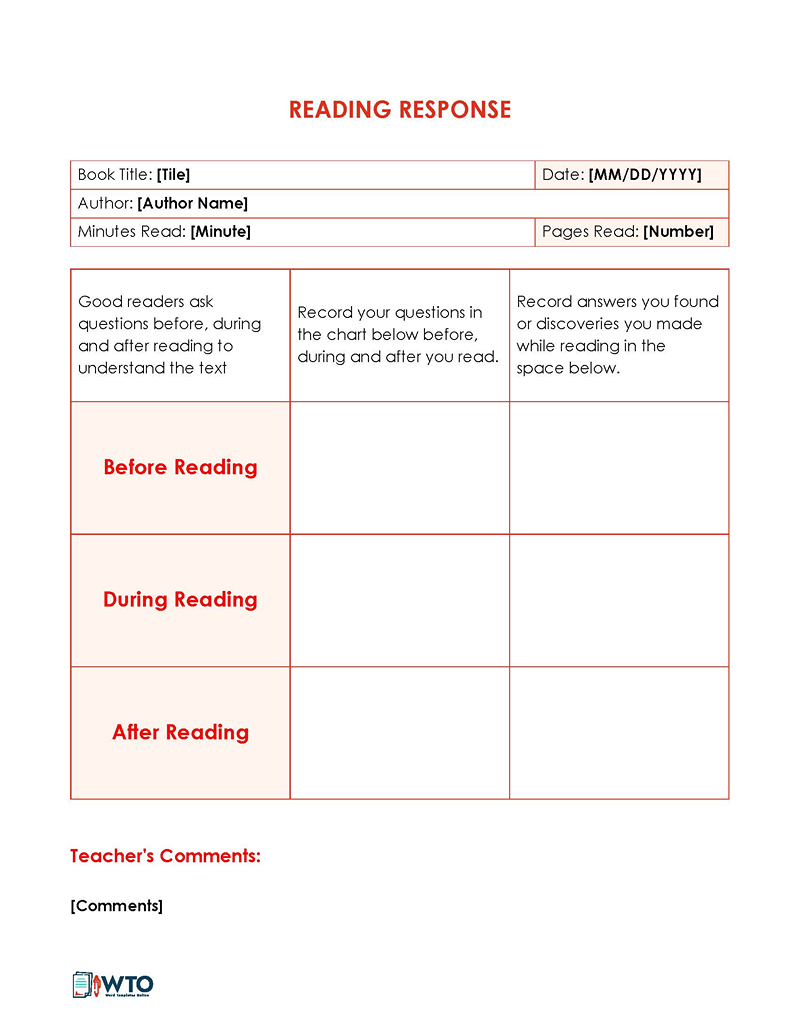
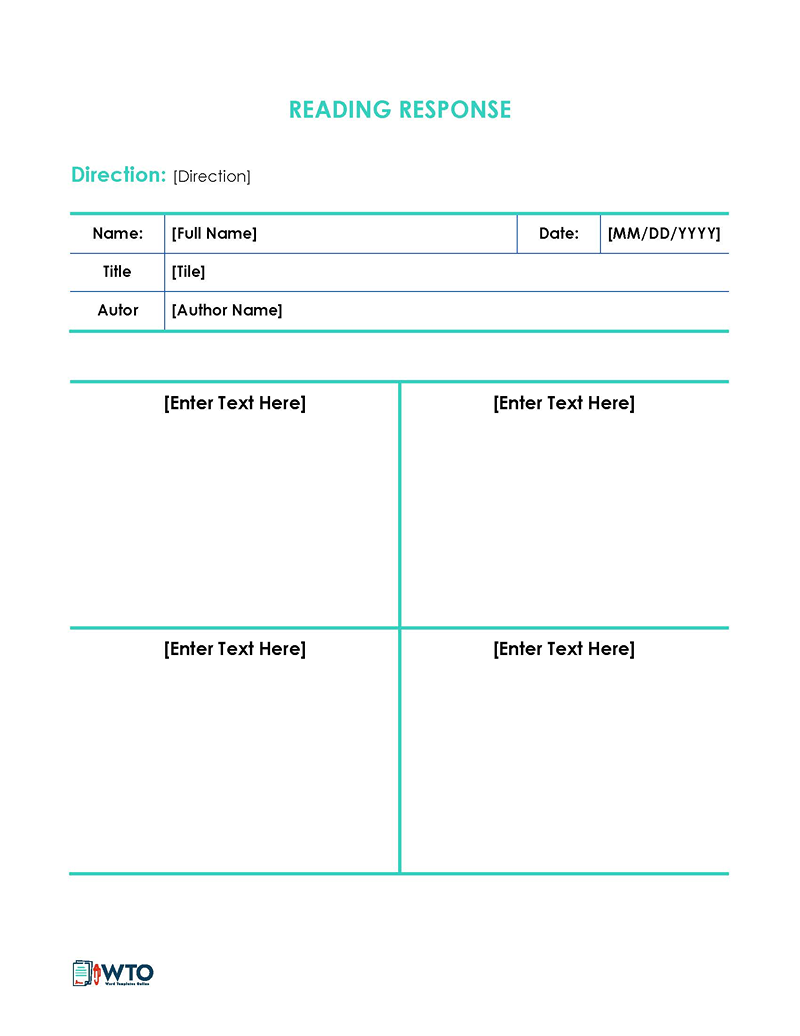
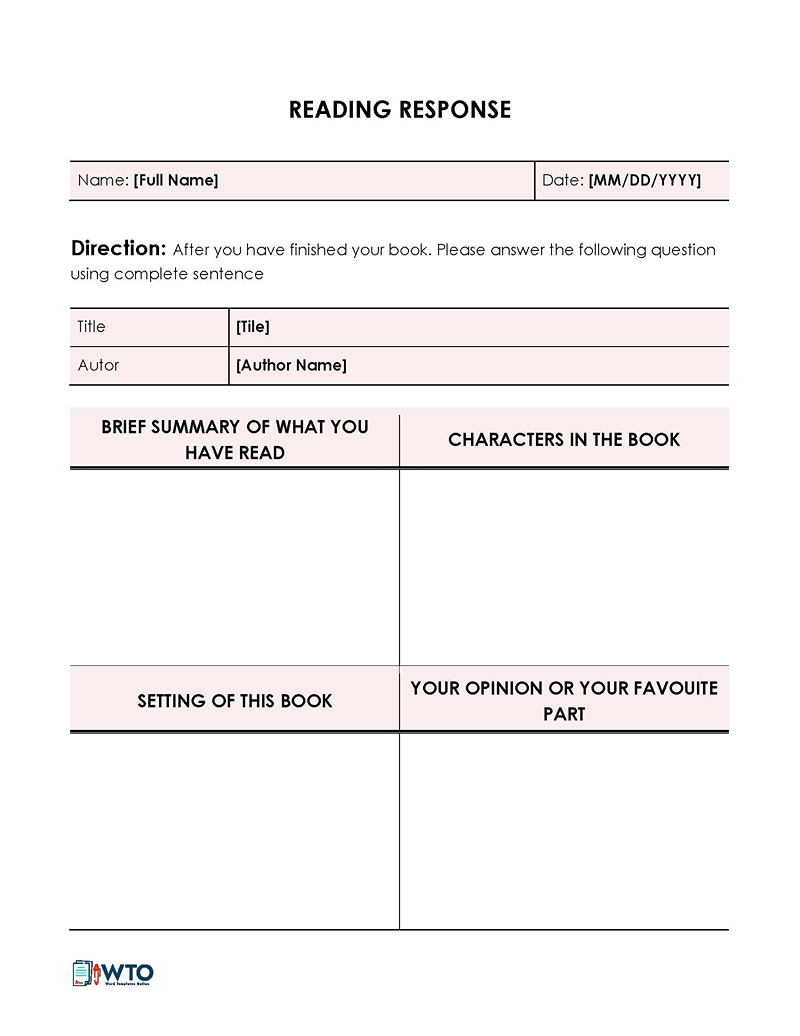
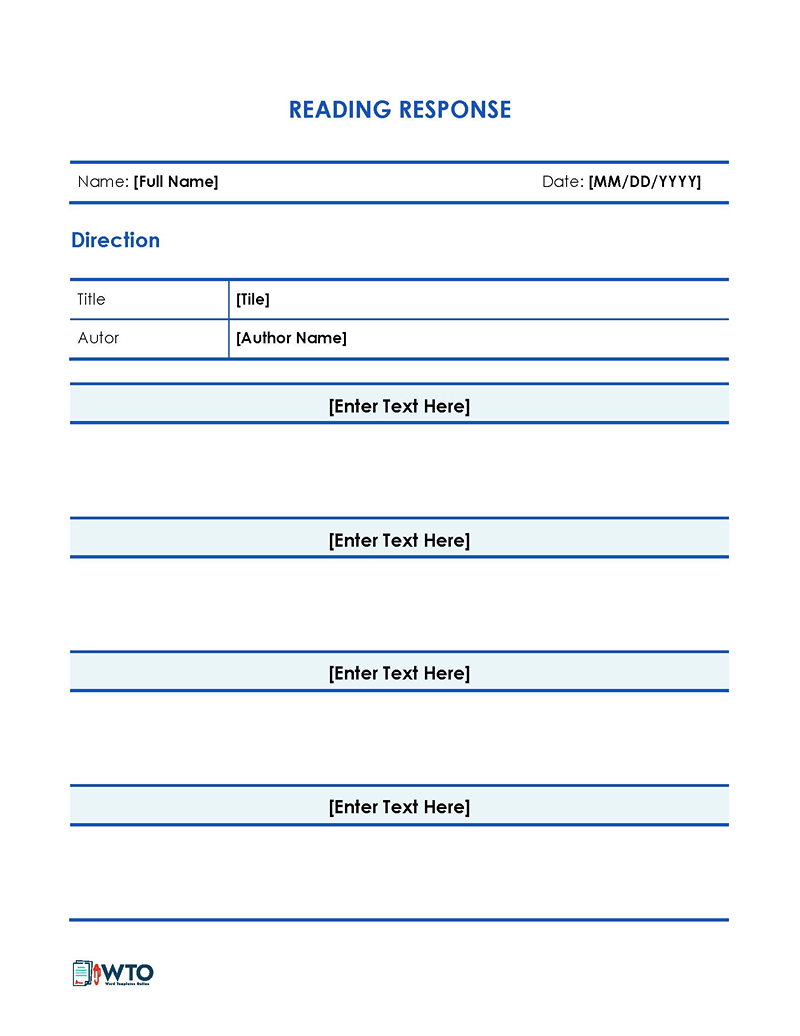
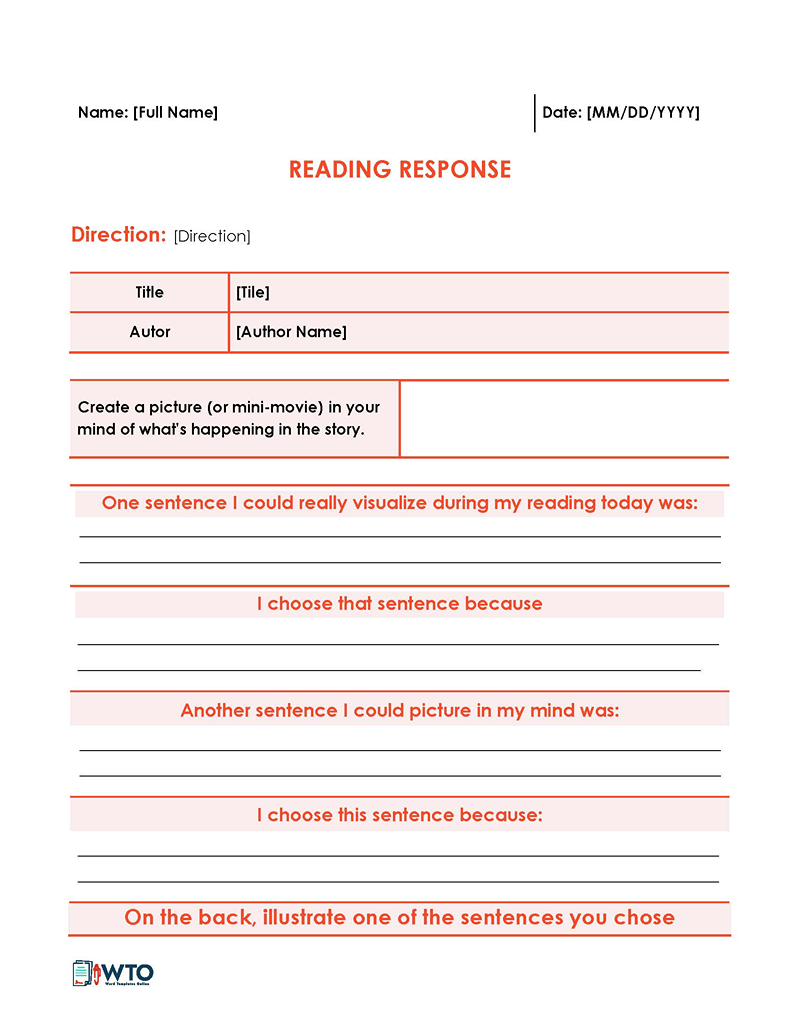
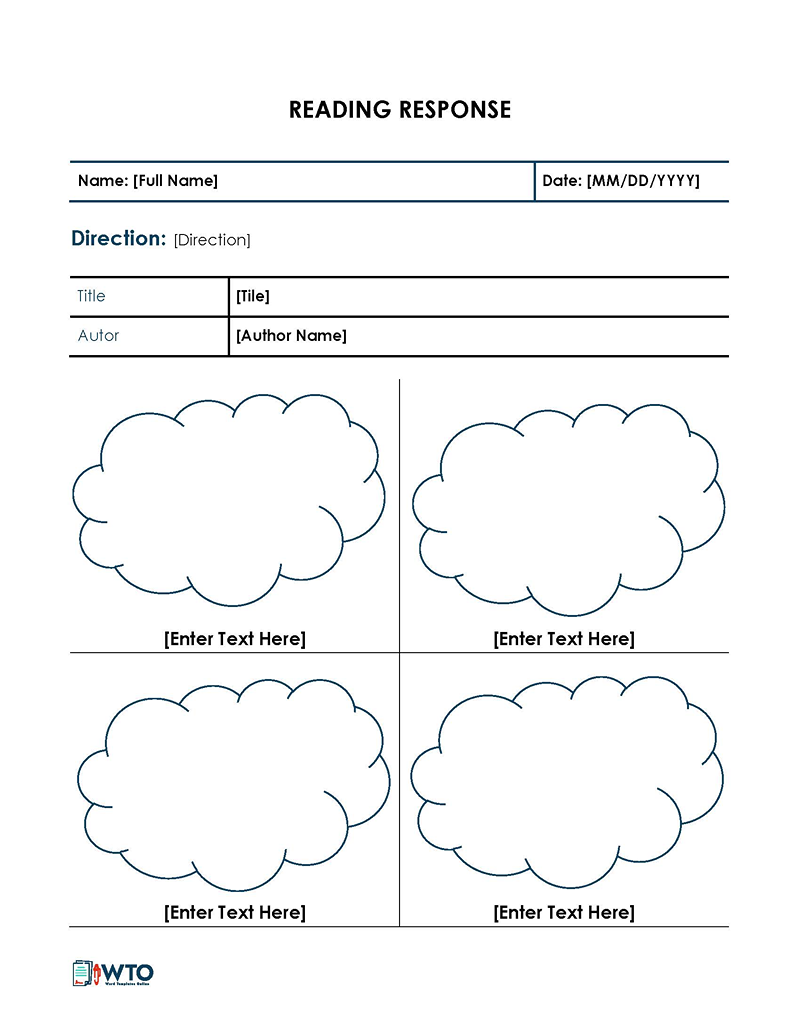
Significance of a Reading Response
It is a critical and analytical evaluation of a text that a reader writes after reading it. It aims to engage you with the text, deepen your understanding of the material, and identify the main purpose of the text.
Below are some of the benefits of the response:
Improved understanding
It can help you effectively analyze and understand the text by allowing you to engage with it on multiple levels. You can categorize your response as a summary, an analysis or evaluation, or a reflection. This means that it helps to expand and improve your understanding of the theme of the text.
Development of critical thinking skills
It helps develop your critical thinking skills. You will have to critically analyze the arguments presented by the author, review your perspective, and reflect on the text’s importance. Doing this will make you an analytical reader and a critical thinker.
Effective communication
The framework allows you to effectively communicate your ideas and views about the reading material. It has a structure that you can use to format your response, organize your thoughts, and then present your analysis coherently and concisely
pro tip
You can use a template for writing your response to a reading or text. However, when using it, remember to prioritize your own unique perspective and insights. Templates can help organize your thoughts, but your response needs to reflect your own thoughts, opinions, and experiences. Therefore, be sure to express your thoughts freely.
Personal growth and development
Writing the response can facilitate your personal growth and development. This is because it allows you to consider your own perspectives, beliefs, values, and experiences in relation to the text. That way, you can understand yourself and the world around you better.
Improved organization
It allows you to organize your thoughts and ideas about the reading material effectively. With this structure, you can easily identify and arrange key elements from the text so as to develop a logical and detailed analysis. That way, your response essay will always be focused and contain properly arranged ideas.
How to Write a Reading Response: 3 Key Steps
There are three key steps that you should follow when writing the response. They include the following:
Step 1: Introduction
The introduction should provide context for the text by including any relevant information about its genre and other details. You can also provide the name of the text and its author. You should explain the text’s importance by briefly describing its background and impact. In addition, provide your thesis statement or argument at this stage.
EXAMPLE
One of Franklin Victor’s well-known poems, XYZ African Tales, focuses on life as seen from various social perspectives. The poet is known for his psychoanalytic poems that leave his readers looking at life through a different lens. The poem in question examines how greed, materialism, and a lack of moral values hinder people from achieving their dreams. The poem tries to remind people that working hard is the only way to success, and trying to reach their dreams through the wrong channels attracts failure in the long run.
note
Customize your template to accommodate the requirements of the assignment and your own writing style. Add or remove sections, and adjust the order of sections as needed. Remember, the template is a flexible structure for organizing your thoughts, so do not hesitate to modify it according to your needs.
Step 2: Body Paragraphs
Focus on discussing the text in a critical manner in the body paragraphs. You should include three or four paragraphs that focus on addressing all the relevant prompts or questions in the response. You do not have to answer questions or respond to each prompt separately. You can combine multiple questions and answer them in one paragraph or re-arrange them to ensure your essay has a coherent flow.
The paragraphs will have the following major sections:
Summary
The summary section contains an overview, main points, a plot line, and major themes. This is done to establish the tone for the rest of your body paragraphs and make it possible for you to do a thorough analysis of the text. You should also describe the structure, main arguments, and supporting evidence of the text here.
Analysis
Provide your personal analysis next on how, what, and why the text made you feel a certain way, along with one or two specific examples that support your claim. Ensure that you explore the text’s themes and key points in detail. You can also review the language and tone of the text. This way, you will easily identify its strengths and weaknesses and explore other possible explanations of the text.
Evaluation
This section will assess the overall value and significance of the text. This involves a deeper analysis of the text, determining its effectiveness, and establishing its impact. You should consider the text’s relevance, its contribution to a specific subject, and its existing biases or limitations. In addition, you should include quotations, whether direct or paraphrased, from the text to support your statements.
Connection
In the response, “connection” refers to the act of relating the text being read to personal experiences, prior knowledge, or other works of literature. It involves drawing parallels or finding similarities between the ideas, themes, characters, or events in the text and one’s own life or other sources of information.
Choose quotes that directly support the point you are making or illustrate the idea you want to discuss. Look for passages that are significant, memorable, or particularly well-written. Provide some context or a brief explanation before including the quote.
Reflection
Reflection in the response refers to the act of critically thinking about and analyzing the text you have read. It involves considering your own thoughts, feelings, and interpretations in response to the material and examining the impact it has had on you. It helps you develop a more thoughtful and nuanced understanding of the text, while also encouraging self-awareness and personal growth as a reader.
EXAMPLE
In “The Great Gatsby” by F. Scott Fitzgerald, Gatsby’s pursuit of Daisy is more about reclaiming his lost identity than it is about love. As a self-made man, Gatsby has reinvented himself as a wealthy socialite to fit in with the elite society that Daisy is a part of. Winning her back is a way for him to prove to himself and others that he has succeeded in his quest for social acceptance. While his actions are misguided, they are also poignant in their desperation. This portrayal of Gatsby’s inner turmoil and the lengths he is willing to go to achieve his goals is both compelling and tragic. This section made me reflect on how we all strive for acceptance and recognition in our lives and the potential consequences of chasing after these ideals at any cost.
tip
After using a template for writing your response, review and revise it to improve clarity and coherence. Consider rearranging or rewording sections, adding analysis or evaluation, and seeking feedback from peers or instructors.
Step 3: Conclusion
For the last step, summarize your argument and restate your thesis or main points. You should also include your final thoughts or recommendations. The conclusion and a clear understanding of the text’s main ideas or arguments should be provided in this section, which should be one paragraph long. Your points should be presented logically but should not be unnecessarily long.
EXAMPLE
Franklin’s poem tries to intrigue its readers into considering the cost of achieving one’s dreams and how it affects others in society. He wants to highlight how the failures and downfalls of society weigh differently on different people. Using these ‘wrong channels’ to achieve one’s ambitions is not beneficial, but Franklin challenges readers to consider societal status, that is, low and high-class citizens. Both Philip and Peter faced consequences, but their status determined how brutal they were. Consider this: Philip’s greed cost him his family, his freedom, and his wealth, whereas Peter bought his freedom, kept his wealth, and lost his family.
note
When writing a response to a text, you can use the free downloadable templates provided on our website for ease. They can be customized and are easy to use. In addition, they are available in PDF format to keep the document’s structure intact.
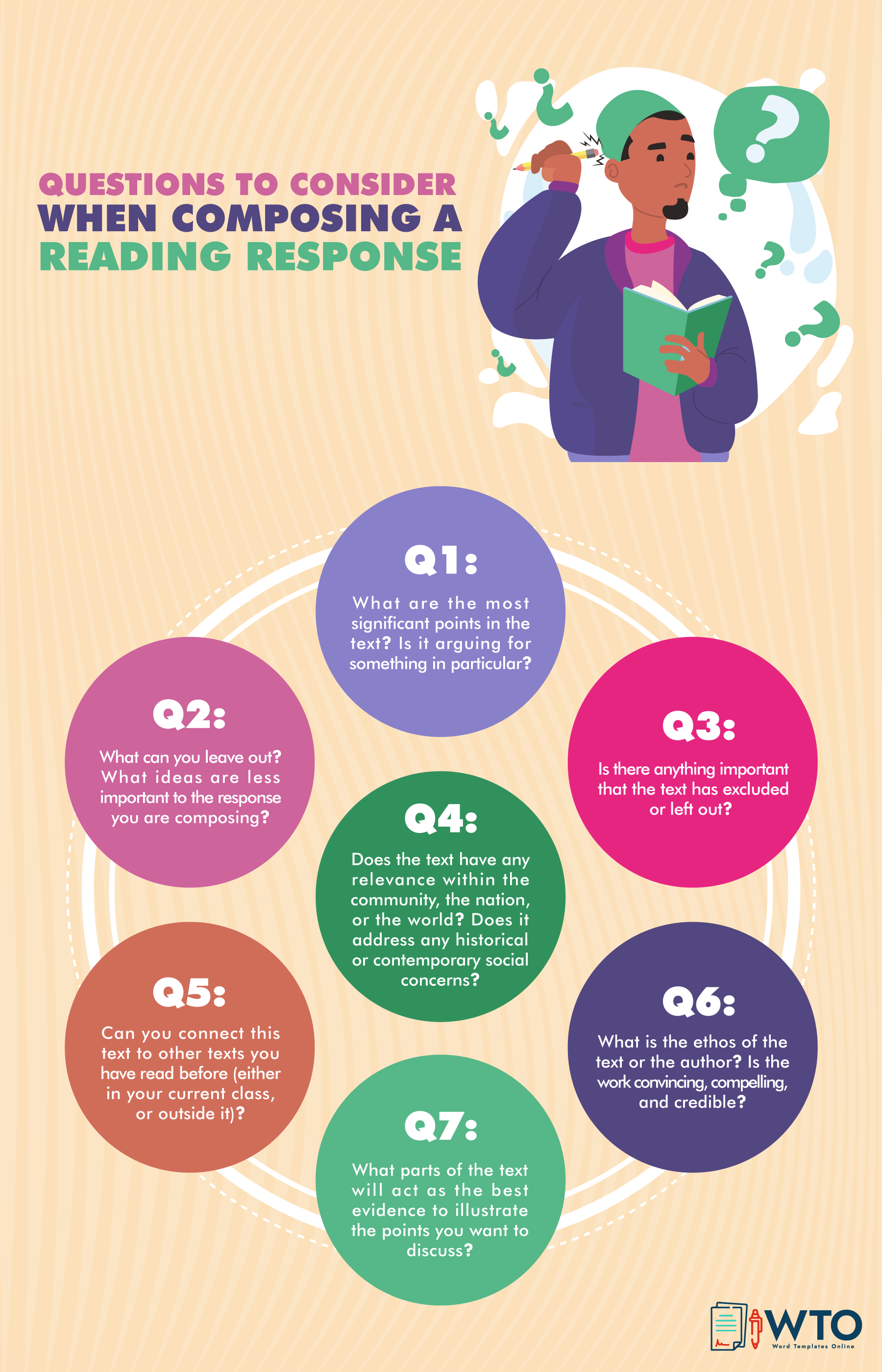
Types of Reading Response Templates
There are various templates and structures that can be used as a framework for organizing the response. These templates can help you structure your thoughts, ensure coherence, and provide a clear flow to your writing.
Here are a few common templates for reading responses:
Journal reading response
Use this template to record your personal response to a text. It is usually written in a free-form style. The journal should include thoughts on your personal experiences, emotional reactions, and connections to the text. This format encourages you to explore the text personally based on your thoughts and feelings.
Essay reading response template
Your response to a text should adopt a formal and structured style for the essay template. Use an academic formatting style such as APA or MLA. Ensure that you include an introduction, a thesis statement, body paragraphs (with supporting evidence and analysis), and a conclusion. Your focus should be to provide a critical, detailed, and persuasive argument in response to the text.
Letter reading response template
This document has an informal and conversational style of writing. You should include a summary of the text alongside your personal thoughts and reactions. Your goal should be to interact with the text personally while providing your reflections and feelings in a casual format.
Log reading response template
For this template, you should organize your response chronologically or based on themes. The log may include a summary, an analysis, and your personal thoughts. In addition, you may include notes on your reading progress and understanding of the text. The purpose of this format is to encourage you to engage with the text for a longer period of time and to think critically about your own understanding.
Elementary reading response template
This template is meant to guide young readers and students using prompts or questions. As an elementary reader, the goal is to develop your critical thinking skills and help you approach literature in a fun way. You will be able to engage with the text in a meaningful manner by summarizing it, highlighting the key characters or events, and reflecting on your personal reactions or connections to it.
Non-fiction reading response template
You can prepare the response for a non-fiction text using the prompts or questions provided in the template. It also has sections meant for summaries, analysis, supporting arguments, and reflections on the relation of the text to other issues. Your focus should be to identify its strengths and weaknesses while reviewing all other interpretations.
Do’s and Don’ts of Writing a Reading Response
There are some tips that you need to consider when writing a reader response. These do’s and don’ts include the following:
Do’s
- Cite or paraphrase any quotes depending on the style you are using.
- Include a “works cited” or a bibliography page.
- Maintain the word limit or page count required for the assignment.
- Include a thesis statement or a main argument based on the overall impression of the text or a particular central question.
- Use samples or templates to understand the structure and format of the document.
- Examine the text’s context by considering how it relates to other texts you may have read.
- Read the text carefully before writing a response.
- Highlight important sections of the text or note their page numbers while reviewing it.
- Structure and format your response like an essay.
Don’ts
- Don’t start your response immediately after reading your text. Take some time to think about the entire text, determine how it makes you feel, and make some notes.
- Don’t use long or block quotations.
- Don’t fail to include supporting evidence from the text in your response.
- Don’t fail to provide comprehensive reasoning for your opinions about the text.
- Don’t share your work without revising and proofreading it first.
Bottom Line
A template for writing a reading response is a tool that can help you structure and organize your responses to a text. It has sections meant to guide you when writing your reaction. You will have prompts or questions to help you analyze and evaluate different aspects of the text. This way, you can prepare a clear and coherent response meant to develop your critical thinking skills. Ensure that you use a template to write a response essay, as it will save you time and simplify a complex task into manageable steps.




